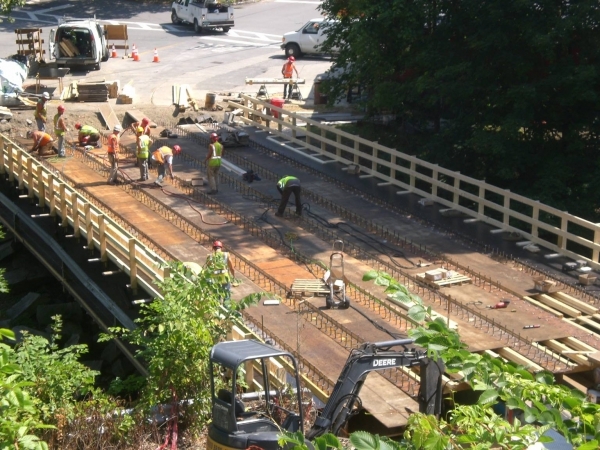BRATTLEBORO — The Elliot Street Bridge reopened at the end of August, right on schedule.
The state Agency of Transportation, in partnership with the town of Brattleboro, closed the 1946 bridge June 27 to replace the bridge's surface, called “the deck.”
Working under the state's deck replacement program and accelerated bridge program, local contractor Renaud Brothers of Vernon completed the project within two months.
According to Agency staff, many bridge projects can take years to complete. The Elliot Street Bridge repair project took less time because only the deck needed replacement. The town agreed to close the bridge completely and detour traffic because of the project's relative simplicity.
The bridge provides a popular bypass of downtown from the Western Avenue area of town to Canal Street.
Two years ago, the town's Department of Public Works reduced the bridge to one lane after an 8-foot-by-10-foot hole formed in the bridge's deck.
A team effort
In a news release, town officials directed praise to Secretary of Transportation Chris Cole, resident engineer Chad Greenwood, local Agency of Transportation District 2 staff, and Agency Project Manager Jennifer Fitch.
Town officials also thanked Public Works Director Steve Barrett and Water & Highway Superintendent Hannah O'Connell for serving as the town's representative. DPW employees also upgraded nearby water and sewer lines.
Joe Newton of the Brattleboro Fire Department helped coordinate the relocating of power and communication lines along with regional utility companies.
Replacing the bridge's deck cost $512,893, according to the town. The Agency of Transportation funded 97.5 percent of the project with the town providing a local match of $13,151.
“That was a fantastic project,” said Fitch, adding that the cost of completely replacing the entire bridge would have cost at least $1.2 million.
According to Fitch, the town reduced its costs by taking advantage of a state statute that reduces the town's share of construction costs.
Under the statute, if a town agrees to close a road and bridge during construction, then its share of the costs are cut in half, she said.
Typically, with repair and rehabilitation projects, the share of costs break out to 80 percent paid by the federal government, 15 percent paid by the state, and 5 percent paid by the town, Fitch said. Under the statute, the state increases its share to 17.5 percent and the town's portion falls to 2.5 percent.
Two state programs
Repairs to the Elliot Street Bridge were governed by two state programs, she said.
The accelerated bridge program aims to reduce bridge construction from the common five-year timeline to two to four years.
The state created the program in 2012 in the wake of Tropical Storm Irene. According to Fitch, it accomplishes its shorter timelines in part by closing bridges and corresponding roads during construction.
Most bridge projects involve building a temporary bridge or allowing one lane of traffic to cross during construction.
Closing the bridge to traffic or pedestrians reduces, in Fitch's words, “the impacts” on resources like time or the environment, which also reduces project costs.
The second program that helped the Elliot Street Bridge is the Deck Preservation Program, which the state launched in the fall of 2015. Ten bridges were identified for the program, Fitch said.
To make the cut, the selected bridges needed to have a strong superstructure - support beams, abutments - but a damaged deck, she added.
“The deck is really important because the deck is essentially a roof,” Fitch said.
Similar to a building's roof, a bridge deck protects the support structure from water, salt, and other corrosive substances.
“Retarding deterioration” prolongs a bridge's lifespan, she said.
The new deck is expected to extend the bridge's lifespan by 40 years, she said.
On a fast track
The design and construction part of the Elliot Street Bridge project took 5 1/2 months rather than the usual 24 months, Fitch said, highlighting three factors that led to the short timeline.
“The town of Brattleboro was fantastic,” Fitch said. “They have a fantastic team down there.”
Closing the bridge completely kept the project on track, she said.
Finally, the project's focus - the bridge deck - meant the state didn't need to deal with any right-of-way issues because the project didn't extend beyond its existing footprint, Fitch said.
The project's few cultural or environmental issues were quickly dealt with. These included concerns for potential bat nesting areas and preservation of historic aspects of the 70-year old bridge, such as its railing, Fitch continued.
Again, Fitch points to close collaborations helping to mitigate the bat and preservation concerns.
Staff members of the Agency of Natural Resources made a winter trek to Brattleboro to investigate bat populations around the bridge, Fitch said. They found none, she added.
In recent years, the state enacted new rules to protect bat populations hit by a fungus called White Nose Bat Syndrome.
The Agency of Transportation's in-house historic preservation staff assembled replicas of 1940s era bridge railings. The town staff and Selectboard chose a style of replica railing first created for a similar-aged bridge in Barre, Fitch said.
This project allowed the project team to “stretch and grow and try some new strategies,” she said.
